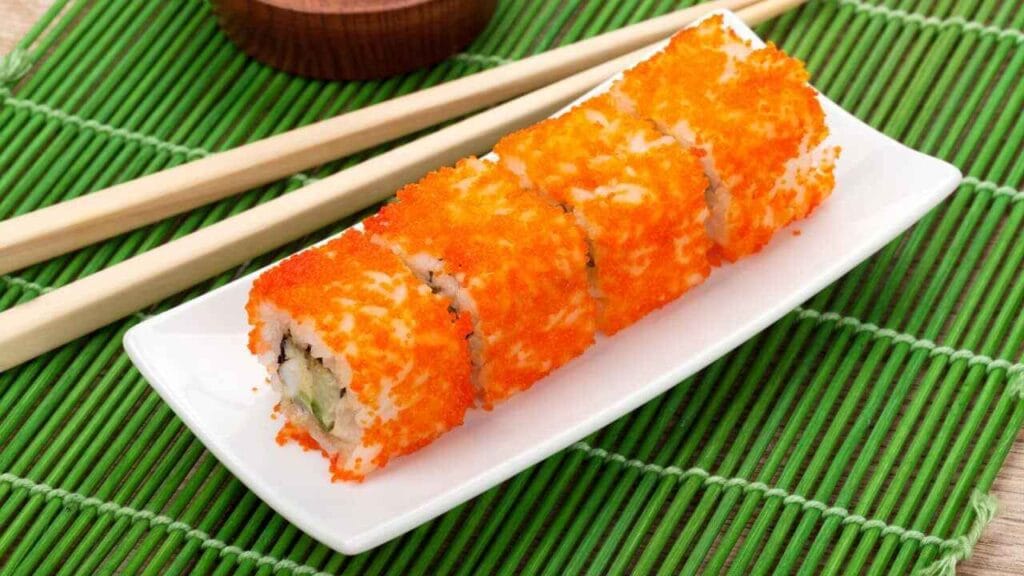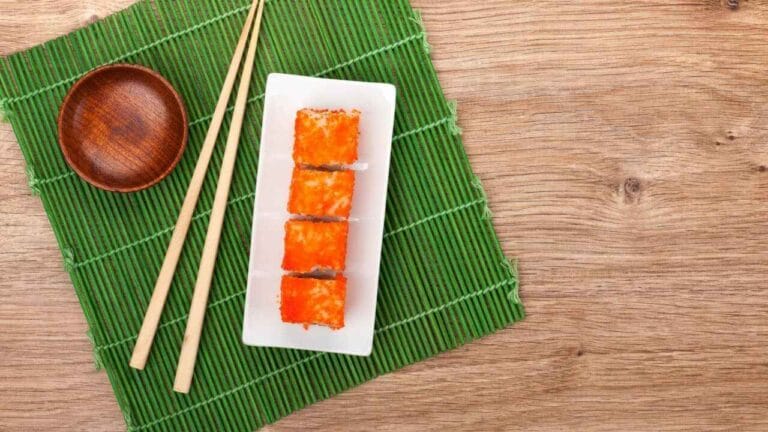Tobiko is a type of fish roe that comes from flying fish. It’s small, crunchy, and full of flavor. Known for its bright orange color, it’s a popular ingredient in Japanese cuisine. You’ve probably seen it on sushi rolls, adding both taste and beauty. But there’s a lot more to tobiko than meets the eye. Let’s dive into its origins, varieties, and how you can use it at home.
Table of Contents
The Origins of Tobiko: A Culinary Treasure
Tobiko in Traditional Japanese Cuisine
Tobiko has been part of Japanese cooking for centuries. In Japan, it’s loved for its crunchy texture and smoky flavor. It’s often used to top sushi rolls or added to sashimi for a little extra flair. Chefs carefully pair it with other ingredients to create balanced and delicious dishes.
Its bright orange color is also a symbol of freshness and quality. When you see tobiko on sushi, you know the chef has put care into their work. It’s not just an ingredient—it’s a sign of craftsmanship.
How Tobiko is Harvested: Behind the Scenes
The process of getting tobiko is interesting. Flying fish lay their eggs in warm, tropical waters. Fishermen collect these eggs during the spawning season. Once harvested, the eggs are cured in a salt solution. This keeps them fresh and gives them their signature smoky taste.
Natural tobiko is orange, but it’s often dyed to create other colors. For example, squid ink makes black tobiko, wasabi creates green, and yuzu adds a yellow color. These variations not only look beautiful but also bring different flavors to the table.
Varieties of Tobiko: Exploring the Rainbow of Flavors
Natural vs. Colored Roe: What You Need to Know
The natural color of roe is bright orange. It has a mild flavor with a hint of smokiness. However, chefs often use dyed roe to add variety. Black roe, flavored with squid ink, has a rich, earthy taste. Green roe, made with wasabi, is spicy and bold. Yellow roe, infused with yuzu, offers a fresh citrus flavor.
Each type of roe adds its own twist to dishes. For example, green roe might pair well with spicy rolls, while yellow roe can brighten up a citrusy dish. Mixing different colors is a fun way to make your meals look more exciting.
Nutritional Benefits of Roe
Roe is not just tasty—it’s healthy too! It’s low in calories but high in protein and omega-3 fatty acids. These nutrients are good for your heart and brain. Roe also contains vitamins that support overall health.
| Nutrient | Per 1 oz (28g) |
|---|---|
| Calories | 40 |
| Protein | 5g |
| Fat | 2g |
| Sodium | 380mg |
| Omega-3 Fatty Acids | High |
If you’re looking for a nutritious ingredient to add to your meals, tobiko is a great choice. It’s a small addition that packs a big punch!
Popular Dishes Featuring Tobiko
Sushi Creations Highlighting Tobiko
Sushi is where tobiko shines. Its bright color and crunchy texture make it perfect for topping rolls like the California roll or spicy tuna roll. Some chefs use it to create “tobiko bombs,” where a big scoop of tobiko is added to sushi for a burst of flavor.
But tobiko isn’t just for rolls. It’s also used to garnish nigiri or mixed into sauces for a unique twist. Have you ever had sushi that looks like a piece of art? Tobiko might be the secret behind its beauty.
Tobiko in Modern Fusion Cuisine
These days, tobiko isn’t just for Japanese food. Chefs all over the world are finding creative ways to use it. You might see it sprinkled over pasta or even on avocado toast. Its bright color makes any dish look fancy, while its crunch adds an unexpected texture.
“Tobiko is a small ingredient, but it can make a big difference. It’s the cherry on top of any seafood dish!”
How to Use It in Home Cooking
Simple Recipes for Beginners
Making meals with it is easier than you think! Start with a basic sushi roll. Grab some nori sheets, sushi rice, and fillings like cucumber, crab, or avocado. Roll everything up and sprinkle it on top. Voilà—your homemade sushi looks and tastes like it came from a restaurant.
Want to get creative? Mix it into a creamy pasta sauce for a seafood twist. Or use it to garnish salads, especially seafood ones. Its pop of color and crunch will take your dishes to the next level. The possibilities are endless, so don’t be afraid to try new ideas.
Best Ingredients to Pair with It
It is a team player in the kitchen. It goes beautifully with creamy and mild ingredients. Try pairing it with avocado or cream cheese for a smooth, rich contrast. Seafood like shrimp and scallops also match its salty, crunchy goodness perfectly.
Need inspiration? Check out this delicious Shrimp Sushi Delight recipe. It’s a tasty way to explore how it works in seafood dishes and beyond.
Tobiko vs. Other Fish Roe: How It Stands Out
Tobiko vs. Ikura: Key Differences
At First Glance: Comparing It and Ikura
At first glance, it and ikura (salmon roe) might seem similar. Both are fish eggs, and both are popular in Japanese cuisine. But their differences are easy to spot once you look closer. It is much smaller than ikura. While it is tiny and crunchy, ikura is large, juicy, and bursts with flavor when bitten into.
Their flavors are also quite different. It has a mild, smoky taste with a slight sweetness, while ikura is richer and more intense. Ikura is often enjoyed on its own, while it shines as a topping or garnish. Both are delicious, but they serve different roles in a dish.
Comparing It and Masago
Masago, the roe from capelin fish, is another common comparison. Like it, masago is small and often used in sushi. However, masago is less crunchy and has a milder flavor. It’s also less vibrant, with a pale orange color compared to its bright hues.
Masago is often used as a substitute for it because it’s more affordable. But true lovers of it know the difference. Its texture, flavor, and visual appeal make it stand out from masago in any dish.

Common Problems When Using Tobiko and Their Solutions
Addressing Freshness and Storage Issues
One of the most common issues with tobiko is maintaining its freshness. Tobiko is delicate and needs to be stored properly to keep its flavor and texture intact. Always store it in an airtight container in the fridge. It can last up to a week if kept cold and sealed.
Want to keep it longer? Freezing tobiko is a great option. Divide it into smaller portions and freeze them individually. When you’re ready to use it, thaw only what you need. This way, you can enjoy fresh tobiko anytime without waste.
How to Source High-Quality Tobiko
Finding authentic, high-quality tobiko can be a challenge, especially if you’re new to seafood. Look for tobiko that has a vibrant color and a firm texture. It shouldn’t be watery or overly soft. Trusted specialty stores or seafood markets are your best bet.
If you’re buying online, read reviews carefully. Many reputable retailers offer fresh or frozen tobiko delivered to your door. Check the ingredients list too. Pure tobiko should contain roe and minimal additives, like salt or natural flavorings.
Tobiko Around the World: A Global Perspective
Tobiko’s Influence on International Cuisines
From Japan to the World: Its Global Appeal
While it originates from Japan, its appeal has spread far and wide. In the United States, it’s a popular addition to sushi rolls and poke bowls. Chefs in Europe often use it to garnish seafood dishes or add a pop of color to appetizers.
In fusion cuisine, it has become a creative ingredient. You might find it in unexpected dishes, like it-topped nachos or even it-infused dips. Its versatility and unique texture make it a favorite for chefs experimenting with global flavors.
Sustainable Practices in Its Production
As it grows in popularity, sustainability becomes a concern. Overfishing of flying fish can impact marine ecosystems. Many producers are now adopting sustainable methods to minimize their environmental footprint. For example, some harvest roe from farm-raised flying fish rather than wild populations.
Consumers can support sustainability by choosing brands that prioritize eco-friendly practices. Look for certifications or research the company’s harvesting methods to ensure your purchase comes from responsible sources.
Where to Buy Tobiko: A Shopper’s Guide
Best Online and Offline Retailers for Tobiko
If you’re looking to buy tobiko, you have plenty of options. Local Asian markets often carry it in their seafood section, either fresh or frozen. Specialty stores that focus on Japanese cuisine are another reliable source.
Prefer shopping online? Many retailers now sell tobiko and deliver it straight to your door. Some popular sites even offer different varieties, like wasabi tobiko or yuzu tobiko. Just be sure to choose a reputable seller with good reviews to guarantee freshness.
How to Spot Authentic Tobiko
Not all tobiko is created equal. To ensure you’re buying the real deal, check the label carefully. High-quality tobiko should list “flying fish roe” as the main ingredient. Avoid products with artificial dyes or excessive preservatives.
Look at the color and texture too. Authentic tobiko should be bright and firm, not dull or mushy. Trust your instincts—if something looks off, it’s better to shop elsewhere.
FAQs About Tobiko?
Is It Safe to Eat During Pregnancy?
Pregnant women should be cautious with it due to its high sodium content and the risk of bacteria in raw seafood. Always consult a doctor before consuming raw fish roe during pregnancy.
What Makes It Different from Other Fish Roe?
It is smaller and crunchier than many other types of roe. Its mild smoky flavor and bright colors set it apart. It’s also more versatile in dishes, making it a favorite for chefs.
Can It Be Frozen for Long-Term Storage?
Yes! It freezes well and can last for months in the freezer. Divide it into small portions before freezing. This way, you only need to thaw what you’ll use.
How Do You Know If It Has Gone Bad?
Bad it may have a sour smell or an overly soft texture. If it doesn’t look or smell fresh, it’s best to discard it. Always store it properly to extend its shelf life.
What Are the Best Ways to Serve It?
Popular ways to serve it include topping sushi rolls, garnishing seafood dishes, or mixing it into sauces. Its versatility makes it a great addition to many recipes.
What Is the Price Range for It?
The price of it varies depending on its quality and source. It usually costs around $10–$20 for a small container. Specialty varieties, like wasabi, may cost more.
Conclusion: Embracing the Delight of Tobiko
Tobiko is more than just fish roe—it’s a burst of flavor, color, and texture that elevates any dish. Whether you’re enjoying it on sushi, experimenting in the kitchen, or simply admiring its vibrant appearance, tobiko never disappoints. With its rich history, versatility, and health benefits, it’s no wonder tobiko has captured hearts worldwide. So why not give it a try? A sprinkle of tobiko might just be the secret ingredient your next meal needs!

